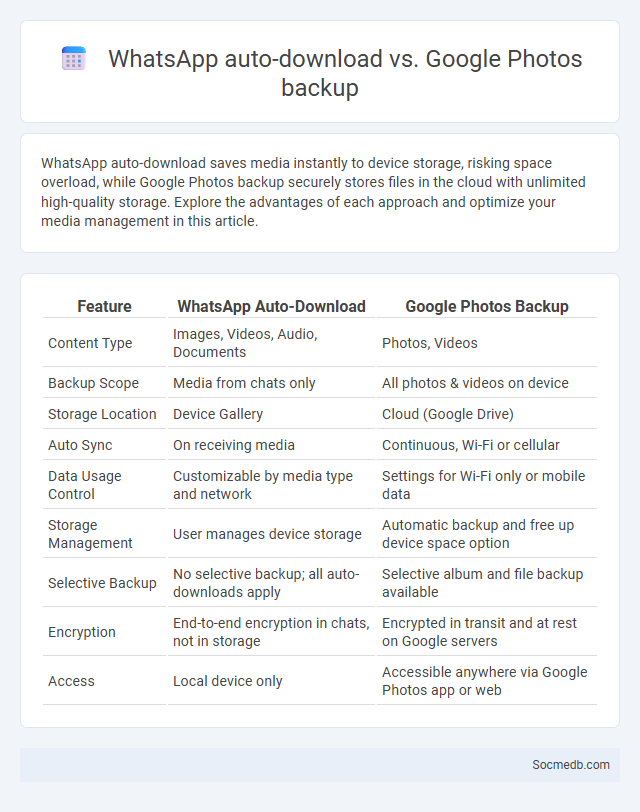
Photo illustration: WhatsApp auto-download vs Google Photos backup
WhatsApp auto-download saves media instantly to device storage, risking space overload, while Google Photos backup securely stores files in the cloud with unlimited high-quality storage. Explore the advantages of each approach and optimize your media management in this article.
Table of Comparison
| Feature | WhatsApp Auto-Download | Google Photos Backup |
|---|---|---|
| Content Type | Images, Videos, Audio, Documents | Photos, Videos |
| Backup Scope | Media from chats only | All photos & videos on device |
| Storage Location | Device Gallery | Cloud (Google Drive) |
| Auto Sync | On receiving media | Continuous, Wi-Fi or cellular |
| Data Usage Control | Customizable by media type and network | Settings for Wi-Fi only or mobile data |
| Storage Management | User manages device storage | Automatic backup and free up device space option |
| Selective Backup | No selective backup; all auto-downloads apply | Selective album and file backup available |
| Encryption | End-to-end encryption in chats, not in storage | Encrypted in transit and at rest on Google servers |
| Access | Local device only | Accessible anywhere via Google Photos app or web |
Overview: Understanding Media Management on WhatsApp and Google Photos
Media management on WhatsApp involves organizing, sharing, and backing up images, videos, and documents through chat threads and cloud storage to ensure efficient access and security. Google Photos offers advanced features like automatic categorization, AI-powered search, and seamless synchronization across devices, enhancing photo and video management. Both platforms emphasize user-friendly interfaces and robust backup options, making media organization accessible and reliable for personal and professional use.
WhatsApp Auto-Download: Features and Functionality
WhatsApp Auto-Download automatically saves incoming media files such as photos, videos, and voice messages to a user's device based on predefined settings. Users can customize auto-download preferences by network type, choosing to download media only on Wi-Fi, mobile data, or when roaming to manage data usage efficiently. This feature ensures seamless media accessibility while allowing control over storage space and data consumption.
Google Photos Backup: How It Works
Google Photos Backup automatically saves your images and videos to your Google account, ensuring secure cloud storage accessible across all devices. It uses AI to organize your media by people, places, and things, making searches fast and intuitive. You can manage your storage settings and backup preferences directly within the app to optimize how your content is saved and shared.
Key Differences: WhatsApp Auto-Download vs Google Photos Backup
WhatsApp auto-download saves media files directly to your device using cellular or Wi-Fi data, optimizing instant access but potentially consuming storage space and data. Google Photos backup uploads photos and videos to the cloud, offering secure storage with smart organization and easy sharing across devices. You can manage WhatsApp's auto-download settings for selective content download, while Google Photos provides automatic backups with options for high-quality or original resolution uploads.
Storage Implications: Device Space and Cloud Usage
Social media platforms generate vast amounts of multimedia content, significantly impacting device storage and cloud usage. High-resolution images, videos, and app data require substantial local storage, often prompting users to rely on cloud services for seamless access and backup. Efficient data compression and cloud optimization technologies are crucial to managing storage demands while delivering smooth user experiences.
Data Usage and Network Considerations
Social media platforms consume significant data through high-resolution images, videos, and live streaming, impacting your overall data usage and mobile plan limits. Network considerations such as connectivity speed, stability, and bandwidth allocation directly affect the loading time and quality of content on platforms like Instagram, TikTok, and Facebook. Optimizing your device settings and monitoring data consumption can enhance performance and prevent unexpected charges on your internet bill.
Privacy and Security: Media Handling Compared
Social media platforms vary significantly in their privacy and security measures, with some offering end-to-end encryption and robust data protection policies while others have more lenient standards that may expose your personal information. Handling media securely involves using platforms that provide granular control over who can view, share, or download your photos and videos, reducing the risk of unauthorized access or misuse. Ensuring your privacy on social media requires regularly reviewing and updating your account settings to match the highest security levels available.
Customization Options: User Control and Flexibility
Social media platforms offer extensive customization options, allowing you to tailor your experience through personalized content feeds, notification settings, and privacy controls. These features provide user control and flexibility, ensuring that the platform adapts to your preferences while safeguarding your data. Enhanced customization empowers you to curate your social media environment for optimal engagement and security.
Use Cases: Best Scenarios for Each Method
Social media excels in brand awareness by leveraging visual platforms like Instagram and TikTok to engage younger audiences through creative content. LinkedIn is ideal for B2B networking and lead generation, connecting professionals with targeted industry insights. Twitter serves real-time communication and customer service scenarios effectively, enabling quick responses and trending topic participation.
Conclusion: Choosing the Right Media Management Solution
Selecting the right social media management solution boosts Your brand's efficiency and engagement across platforms like Instagram, Facebook, and Twitter. Opt for tools offering features such as content scheduling, analytics, and audience targeting to maximize ROI and streamline workflows. Investing in a tailored platform ensures consistent messaging, real-time monitoring, and data-driven decision-making for sustained growth.
 socmedb.com
socmedb.com